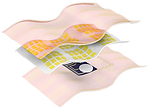


Jun Li, PhD
Materials Scientist
& Biomedical Engineer
I am Jun Li. I am a materials scientist, a biomedical engineer, and an educator.
In my role as a materials scientist, I am passionate about developing and discovering novel responsive materials, with a particular interest in biocrystals with electromechanical couplings (e.g., piezoelectricity).
As a biomedical engineer, I dedicate my efforts to developing advanced manufacturing technologies (particularly 2D and 3D printing techniques) and fabricating biomimetic implantable and wearable devices for medical applications.
My research harnesses the power of materials and biotechnologies to address challenges in sustainability and healthcare.
As an educator, I value teaching and mentoring students. I take pride in empowering students to pursue their academic goals and professional aspirations.
Research Interests
Functional Biocrystals


Advanced Manufacturing


Biomedical Devices


I love crystals at all scales. I am fascinated by the shapes and morphologies of all single crystals. I am thus interested in studying physicochemical properties of crystals, particularly biocrystals that are biocompatible, biodegradable, and bioresorbable. Small biomolecules like amino acids possess chiral symmetry groups, while hierarchical biomaterials such as protein-based polymers (e.g., silk and collagen) and polysaccharides (e.g., cellulose and chitin) form low-symmetric helical and fibrous structures, exhibiting intriguing piezoelectric effect. To me, these biomolecules and biocrystals formed by them are perfect building blocks for next-generation battery-free bioelectronics interfacing tissues and organs.
I enjoy many types of advanced manufacturing technologies, particularly 2D printing and 3D printing technologies. 2D printing like nanolithography allows for creating arrays of millions of nano/micro-crystals on versatile substrates while 3D printing is capable of building almost any complex structures duplicating the morphology and topography of biological systems. I am interested in developing manufacturing technologies to process and print electromechanically responsive biomaterials and create battery-free functional biomedical systems to seamlessly integrate with biological system. These printed systems imitate biology structurally, topologically, and mechanically to provide biological functions such as supporting, restoring and appearance enhancement. Made by responsive biomaterials, these devices respond to biomechanical stimulations, communicating real-time physiological information, and providing micro-electricity for diverse healthcare solutions.
Selected Publications


[1]F. Yang#, J. Li#, et al, Science 2021, 373, 337-342.
[2]J. Li, et al, Nature Communications 2023, 14, 6562.
[3]J. Li, et al, Advanced Materials 2024, 2408153.
[4]J. Li, et al, ACS Nano 2021, 15, 14903-14914.
[5]J. Li, et al, Adv. Funct. Mater. 2020, 30, 2002868.
[6]J. Li, et al, Nano Energy 2021, 90, 106507.
[7]J. Li, et al, Nano Energy 2018, 51, 728-735.
[8]J. Li*, et al, Adv. Funct. Mater. 2024, 2410566.
[9]J. Li, et al, Curr. Opin. Solid State Mater. Sci. 2021, 24, 100806.
[10]J. Li, et al, Acc. Mater. Res. 2021, 2, 739-750





